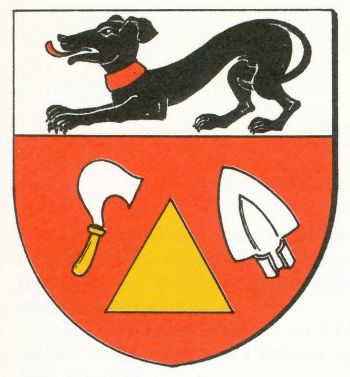Bergholtz: Difference between revisions
Jump to navigation
Jump to search
Knorrepoes (talk | contribs) (Created page with '{|width="100%" style="color:black; background-color:#ffffcc;" |width="15%"|50 px|left |width="70%" align="center" |'''Heraldry of the World<br/>Civic heraldry…') |
Knorrepoes (talk | contribs) No edit summary |
||
| Line 13: | Line 13: | ||
The arms were designed and adopted in 1976. | The arms were designed and adopted in 1976. | ||
The dog in the | The dog in the chief is taken from the arms of the Murbach Abbey, to which the village belonged until the late 18th century. The triangle is a common symbol for Bergholtz, [[Bergholtz-Zell]] and [[Buhl (Haut-Rhin)|Buhl]]. <br> | ||
The plough iron and the grape-knive indicate the importance of agriculture and viticulture for the municipality. | The plough iron and the grape-knive indicate the importance of agriculture and viticulture for the municipality. | ||
Revision as of 06:32, 29 May 2011
| Heraldry of the World Civic heraldry of France - Armorial de France |
BERGHOLTZ
Département : Haut Rhin
Origin/meaning :
The arms were designed and adopted in 1976.
The dog in the chief is taken from the arms of the Murbach Abbey, to which the village belonged until the late 18th century. The triangle is a common symbol for Bergholtz, Bergholtz-Zell and Buhl.
The plough iron and the grape-knive indicate the importance of agriculture and viticulture for the municipality.
Literature : Wilsdorf et al, 1978

